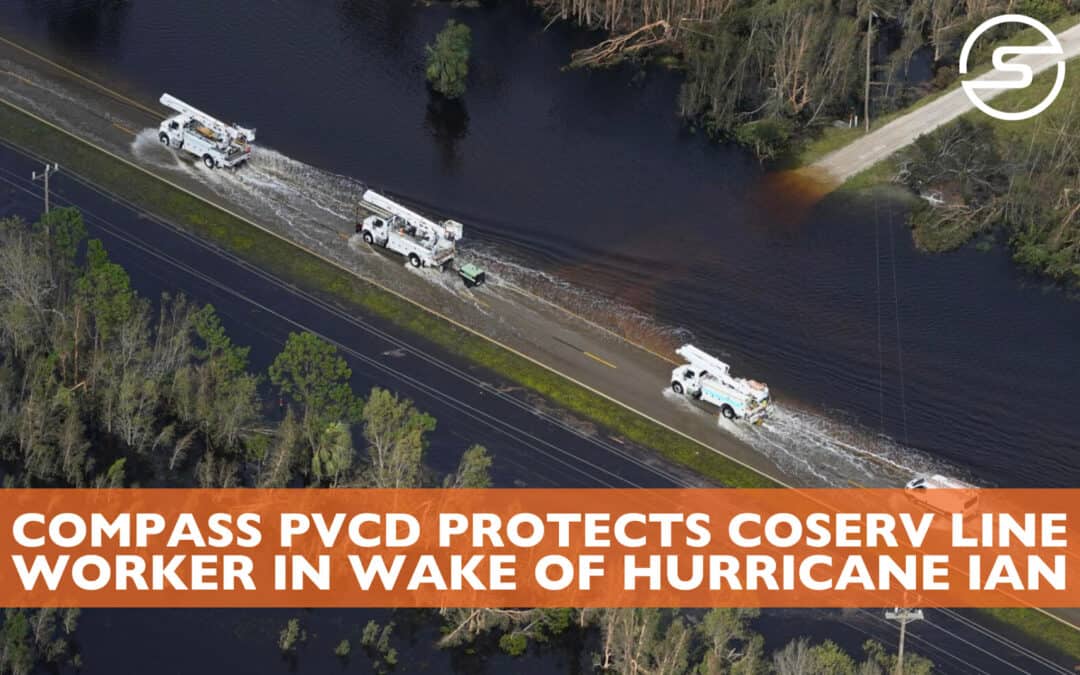COMPASS PVCD Protects CoServ Line Workers in Wake of Hurricane Ian
Before the hurricane reached landfall in Florida, utility companies in Florida ordered thousands of Safeguard Equipment® COMPASS G2 personal voltage and current detectors (PVCDs) in preparation. Safeguard Equipment is an industry leader in building hands-free PVCDs that offer a 360-degree range of detection. These units clip onto a standard hard hat and provide audible and visual warnings of the presence and location of energized threats so that users can avoid shock injuries. PVCDs are critical in responding to storms, when parts of the power grid may be destroyed or damaged, leading to power outages and dangerous electrical hazards.
Hurricane Ian hit the Gulf coast of Florida on September 28 as a Category 4 Hurricane. Line workers from around the country were already lined up to go in and help with hurricane damage. One company that volunteered to help out was CoServ, which sent 17 line workers to Florida. Getting power back on safely and swiftly was the job of the CoServ crews and other line crews working in Florida in the wake of this disaster.
Founded in 1937, CoServ is an electric cooperative providing power and gas to communities located in North Texas. CoServ recently reported to Safeguard Equipment that its COMPASS G2 PVCD may have saved the life of a CoServ line worker.
A CoServ line worker was sent out to repair a jumper that had been broken out of the bottom of a cutout on a transformer. A transformer is a large gray “can” seen near the top of power poles. These devices transform the high-voltage powerlines from substations into low-voltage power so electricity can safely enter residential homes and buildings. On top of these transformers are cutouts that look like rubber plungers. These devices operate like fuses to protect the transformers from power surges or overloads.
The CoServ worker was geared up in PPE, including dielectric gloves and sleeves, as is standard practice. Even so, in this situation, the line workers believed that the line that was being worked would not be energized, because the fuse had blown and was disconnected to the grid. But unknown to the crew, a homeowner had hooked up a generator in such a way that it was back-feeding the line. As the CoServ worker was lifted up in a bucket to repair the jumper, his detector went off. This warning alerted the worker that he was about to work on an energized line.
The proper way to hook up a generator to supply power to a house (or other building) is by using a transfer switch. A transfer switch ensures that the power feed from the primary source (the lines coming into the house from a power company) is disconnected, and power is completely transferred to the generator. Sometimes, however, homeowners will connect a generator directly to the home’s electrical system, which is connected to the grid. If this happens, power produced by the generator will back feed into the utility line. This can energize a line even if a power company has shut off the power.
In this case, the PVCD alert indicated that something was not as it should be, prompting the crew to seek out the source of the problem and eliminate the hazard. Additionally, the alert may have saved the homeowner’s life and property. Improperly installed generators can send electric charge throughout all the home circuits at voltages that the connected appliances are not designed to handle, creating a fire hazard. Problems can easily be heightened if power from the grid is restored to a home that is powered by an improperly installed generator.
Brian Read, CoServ’s Job Safety and Training Specialist acknowledged that safety procedures, training, and using a PVCD were critical to the safety of the worker and the entire crew:
“Thankfully, these guys used their proper training and had equipment that alerted them of a major hazard. I appreciate you guys making a product that continues to save lives!”
Electrical charges cannot be seen, felt, or heard. This story was a perfect reminder that even when the best practices are put in place, there is no question that a PVCD is critical for detecting unseen electrical threats, especially during storm response.
Safeguard Equipment is proud of its efforts to keep workers safe. The thank you note received from CoServ reconfirms our commitment to our mission. We are happy to have been part of the effort to help Florida recover from the hurricane. We will continue to help CoServ and other companies across the country to help their workers return home safely to their families.
Safeguard leads the industry in providing cutting-edge safety solutions for workers who deal with energized lines. Our latest product, the COMPASS Pro emergency response solution, also has arc flash, fall, and impact detection capabilities with an integrated App for summoning emergency response. For more information on the COMPASS G2 PVCD or the COMPASS Pro, contact Safeguard Equipment today.

